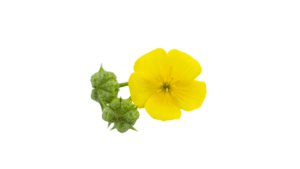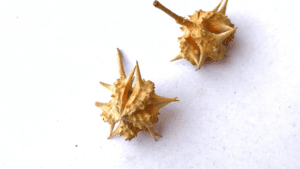Introduction
Tribulus terrestris is a trailing plant well grown in sandy soil and belongs to the family Zygophyllaceae. This plant is known for its medicinal value and is a reputed Ayurvedic drug. It is herbaceous in nature. Tribulus terrestris is commonly distributed in the tropical and subtropical areas and all the warm regions of both the hemisphere. The following article is about the health benefits Tribulus terrestris Linn. and its botanical descriptions.
Common name
Chotagokhru, Gokhuru (Hindi); Bastitaj (Arabic), Charratt (Burma), Chi li, Tsi li Tsi (Chinese), Caelthrops (English), Croix de chevalier (French).
Botanical description
The plant Tribulus terrestris is a small prostrate hairy shrub.
Leaf
Arranged opposite and pinnate unequal. The appearance of the surface of the leaf is hairy with 3-6 leaflets 6-12 mm long. The base is round with a short petiole.
Flowers

Flowers are white and yellow in color with 1 cm long petals. Axillary in position or opposite to the leaf.
Fruits

Fruits are green and spiny in appearance and become brown when dried. The spiny fruits are often glabrous and muriculaetd with two pairs of hard sharp spines one pair longer than the other.
Seeds
There are many seeds in each cocus with transverse partitions between them. They are acidic and oily in nature.
Phytochemicals present in the Tribulus terrestris
The plant is having various important phytochemical compounds in different parts. It is abundant in saponin. The saponin when purified further produces Diosgenin (A), Ruscogenin (B), Gitogenin, etc. Diosgenin is a type of steroidal saponin and is used to cure various diseases (1).
Dried fruits of Terrestris contain semi-drying oil, peroxides, resins, and proteins (2).
This plant is also rich in vitamin C, protein, and calcium. Other secondary metabolites from these plants are flavanoids, alkaloids steroidal sapogenins, beta-sitosterol, etc.
Medicinal properties of Tribulus terrestris
Tribulus terrestris plant is a very important medicinal plant and is the most important ingredient of Ayurvedic preparations. Traditional use of this plant is mainly as diuretic and aphrodisiac and is used in painful micturition. It is also used in the treatment of piles, cough, calculi, and leprosy. This herb is mainly used for genitourinary tract disorders and helps in removing urinary stones.
1. Medicinal properties of leaves
The leaves are diuretic, used as a tonic to increase the menstrual flow, and cure gonorrhea, a decoction is useful as a gargle for mouth troubles and painful gum and also reduces inflammatory (3).
2. Fruits

The fruits are acidic in nature and not good in taste. Although the water extract is not suitable to drink. The seeds are diuretic, and aphrodisiac and used in painful micturition, urinary disorders, and impotence. Also use for cough and cold, scabies, anemia, and ophthalmia.
3. Roots
Appetisier, relief stomach pain, diuretic, carminitiv
Based on experiments done on animal models, the plant is reported to have antimicrobial and antitumor activity.
Health benefits Tribulus terrestris Linn.
1. Antidiabetic activity
The plant contains saponins which are having hypoglycemic properties. The extract helps in reducing the serum glucose, serum triglyceride, and serum cholesterol level (5).
2. Diuretic activity
The seeds and fruits of this plant contain an excessive amount of nitrates and essential oil. This possesses diuretic activity. Studies done on animal models suggest that 5 g/kg body weight Aquarius administration of the seed extract elucidates a positive diuresis (6).
3. Aphrodisiac activity
The extract of Tribulus terrestris enhances the sexual potential in males by increasing the serum testosterone levels (7).
4. Immunomodulatory activity
Saponins from the fruits increase the phagocytosis activity thus, indicating stimulation of nonspecific immune response (8).
5. Improve the heart activity
The extract of this plant helps in protecting the heart cells and also improves heart functions after a heart attack. Saponins present in the plant show significant effects in the treatment of various cardiac diseases including hypertension and coronary heart diseases etc (9).
Side effects
1. The fresh juice of the plant also contains toxic potassium nitrite and other inorganic compounds.
2. Seeds are toxic to the liver. If consumed on regular bases the seeds may cause metamorphosis of the liver cells (4).
